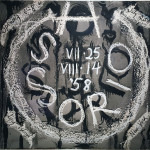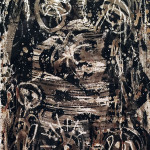Biography
Alfonso Ossorio was born on August 2, 1916 in Manila Bay, on the island of Luzon, Philippines. He grew up in an affluent family; his parents Maria Paz Yangco and Miguel Jose Ossorio had a sugar refinery, among other investments, on the island of Negros. He was schooled in strict Catholic boarding schools in England for several years before his arrival in the United States in 1930. As a young man, he was always surrounded by visual imagery, which would influence his artistic thinking for the rest of his life. His works display a visual struggle with Christian motifs and life and death themes. With his strong Catholic upbringing, he struggled with being a homosexual. His works challenge the viewer to find meaning in a vastly changing time period when scientific theories overshadowed his austere religious background.
After his arrival in the United States, he continued his studies at Portsmouth Priory in Providence, Rhode Island. Upon receiving his American citizenship in 1933, he continued his studies at Harvard University in 1934. Four years later, Ossorio completed his art history thesis at Harvard University. His thesis, “Spiritual influences on the Visual images of Christ,” maps the modification of Christian imagery and iconography compared to social changes in the human understanding of Christianity dating from the earliest Christian era to the Romanesque period.
While at Harvard, he was first introduced to what came to be known as “primitive art.” He also spent hours in the library researching medieval art and illuminated manuscripts. He would spend his summers in Sussex, England in artist Eric Gill’s workshop. Gill encouraged Ossorio to look through illuminated manuscripts like the Book of Kells and practice creating his own wood engravings and illuminations.
Ossorio was married for a short time in the early 1940’s. The Ossorios spent time in Taos, New Mexico. During this period, he painted morose imagery reflecting on his confused state; a visual style that became an unchanging part of his opus.
In 1943, he joined the US army to be a medical illustrator in support of the war effort. His job was to observe and draw surgical procedures and images for others to learn from. Ossorio produced these drawings with an intense fascination with human anatomy. His fixation with the grotesque shocked many who saw his illustrations. He would often go back later and make art works based on these medical illustrations.
It wasn’t until 1949, after seeing a Jackson Pollock exhibition at Betty Parson’s New York gallery, that Ossorio felt a connection to another artist with a similar mindset. He admired Pollock for radically challenging the traditions that society had previously placed on art making in America. The two became good friends and with Pollock’s encouragement, Ossorio went to Paris in 1950 to meet Jean Dubuffet, who would ultimately influence Ossorio’s work. His tendency towards morbid imagery came full circle while working with Dubuffet. The Art Brut or art of the insane criminals and children that he came in contact with helped him seek meaning in a world that he felt had been covered up by social constraints. Because of the free expressive nature of this art making, he found meaning in the art of the children who created spontaneous, colorful creations with true innocence and fervor and the art of the insane criminals who created art without tradition or concern for social order and humanity.
In 1950, Ossorio returned to the Philippines to paint a mural in the Chapel of St. Joseph the Worker on the island of Negros. The island had gone through major destruction and was left desolate after the WWII. The chapel was a memorial commissioned by his family, who owned a sugar refinery there. He spent eight months here painting a cosmic Last Judgment scene.
Ossorio eventually moved from painting to Assemblage. Some of his most well-known Assemblage works are titled Congregations. The term was originally applied to one of his assemblages in 1965 in order to highlight the assortment of unique parts that were combined with one another to create unity and harmony. His Catholic background is a clear connection to this title. In a tape recorded interview, Ossorio stated that he found, “God present in everything…a little waste piece of plastic or a bone is just as much alive as the abstract concept of God, which is meaningless unless it is incarnated.” His works engaged his life-long struggle with themes of life and death, homosexuality, science and religion.
In 1951, he purchased a sixty-acre estate on Georgia Pond in East Hampton, New York called “The Creeks”. He became a connoisseur and collector throughout his career. Most of the works he brought here included the entire Dubuffet Art Brut collection in 1952. At “The Creeks”, he spent the remainder of his life focusing his artistic energy on the creation of sculpture and botanical gardens, which became well-known world-wide for its collection of conifer trees. Alfonso Ossorio died at his New York Hamptons Estate in 1990.

 Untitled
Untitled
 Two Stars (sold)
Two Stars (sold)